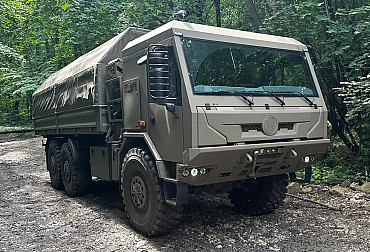Successful acceptance tests of the GF 300 radar for the SAMP/T NG Air Defence System
The SAMP/T NG (Next Generation Medium-Range Surface-to-Air Missile/Ground-Based) Air Defence System has been developed through a cooperative program between Italy and France. Initially designed to manage the Aster family of missiles, it will offer multi-layered defense capabilities by integrating and coordinating short-range (SHORAD) and very short-range (V-SHORAD) anti-aircraft defense systems. The French variant of the SAMP/T NG will rely on Thales’s GF 300 active, rotating, multifunction electronic scanning radar and the ME-NG (New Generation Engagement Module), also produced by Thales. The Aster 30 Block 1NT (New Technology) interceptor missile, equipped with a new Ka-band seeker, can destroy targets, such as ballistic or hypersonic missiles, at an altitude of 25,000 meters and within a radius of 150 kilometers. This capability necessitates a radar with enhanced performance.
Aster 30 B1NT Missile
The family of future ground-to-air systems is designed to provide self-defense for French Navy ships (SAAM), anti-aircraft protection for battle groups, and defense for air bases (SAMP/T). This family includes the Aster 30 and Aster 15 two-stage missiles, featuring a common terminal vector and mission-specific accelerators. The SAMP/T system, equipped with Aster 30 missiles, can engage conventional targets and basic ballistic threats, while the SAAM system, armed with Aster 15 missiles, is tailored to counter saturating attacks from maneuvering missiles, fighter planes, and slower aircraft such as maritime patrol or airborne early warning planes.
The Aster 30 B1NT missile, successfully tested by the DGA (French Defence Procurement Agency) during Operation Mercury in October 2024, marks a significant advancement in protection against emerging airborne threats. Capable of striking targets at an altitude of 25,000 meters and within a 150-kilometer radius, it can intercept medium-range ballistic missiles and hypersonic threats traveling at speeds exceeding Mach 5 (approximately 6,000 km/h). The missile’s autonomous guidance system, featuring an onboard radar for real-time target analysis, ensures reliable differentiation between friendly and hostile entities. This adaptability to complex aerial scenarios represents a technological leap for France and Europe.
Ground Fire 300 Multifunction Ground Radar
For the SAMP/T NG, intended for the French Air & Space Force, the new-generation Ground Fire 300 (GF 300) multifunction ground radar has been selected to replace the current Arabel radar. In July 2020, Thales announced that the GF 300 had entered production. “The electronic and mechanical components of the Ground Fire are developed and produced in collaboration with French SMEs, including Sermati and UMS,” the manufacturer stated at the time.
“This radar builds on years of development for the Sea Fire radar, the naval version chosen to equip the French Navy’s defense and intervention frigates. Ground Fire benefits from Thales’s advancements in artificial intelligence and cybersecurity, enabling it to meet the evolving needs and threats faced by armed forces,” Thales explained. On March 19, 2025, the Organisation Conjointe de Coopération en Matière d’Armement (OCCAr), which manages this program on behalf of France and Italy, announced that the standard GF 300 had passed its factory acceptance tests. The first SAMP/T NG is slated for delivery to the French Air & Space Force by 2026 at the latest.
“Thales is proud to contribute to national sovereignty through its cutting-edge air defense technologies, including the New Generation Engagement Module (NGEM) and the GF 300 radar. The contract for seven additional SAMP/T NG systems for France is a significant step forward for European air defense and reinforces Thales’s role as a trusted partner of the French Air & Space Force,” said Hervé Dammann, Senior Executive Vice-President, Land and Air Systems, Thales.
The acceptance tests were conducted by Thales and MBDA, members of the Eurosam consortium, with support from DGA and OCCAr experts. Factory acceptance tests verify that equipment meets the technical specifications outlined in its terms and conditions and fully satisfies customer requirements. For OCCAr, this milestone confirms the readiness of industrial production lines for the complex manufacturing phase of the new-generation MRI (Identification Radar Module), which will equip the French variant of the SAMP/T NG. The first MRI is currently being integrated with other modules of the initial SAMP/T NG system, scheduled for delivery to the Air & Space Force for testing.
The GF 300 is a digital radar with an active electronically scanned array (AESA) incorporating thousands of Transmitter Receiver Modules (TRMs). This technology enhances detection capacity, improves system reliability, and provides greater resistance to enemy jamming by enabling simultaneous use of multiple frequencies. According to Thales, the GF 300 offers 360° azimuth coverage without blind spots, up to 90° elevation, and a detection range of 400 kilometers, allowing it to track approximately 1,000 targets simultaneously. Versatile, air-transportable, and deployable in under 15 minutes, it also supports missile guidance for intercepting maneuvering or ballistic targets.
Franco-Italian Collaboration
The development of the Aster 30 B1NT and the SAMP/T NG system stems from close collaboration between French and Italian industrial partners. This long-standing strategic partnership has enabled the pooling of expertise and the creation of cutting-edge technologies benefiting both nations. It also serves as a powerful catalyst for the European defense industry, contributing to broader efforts to enhance Europe’s sovereignty and autonomy in defense matters.










